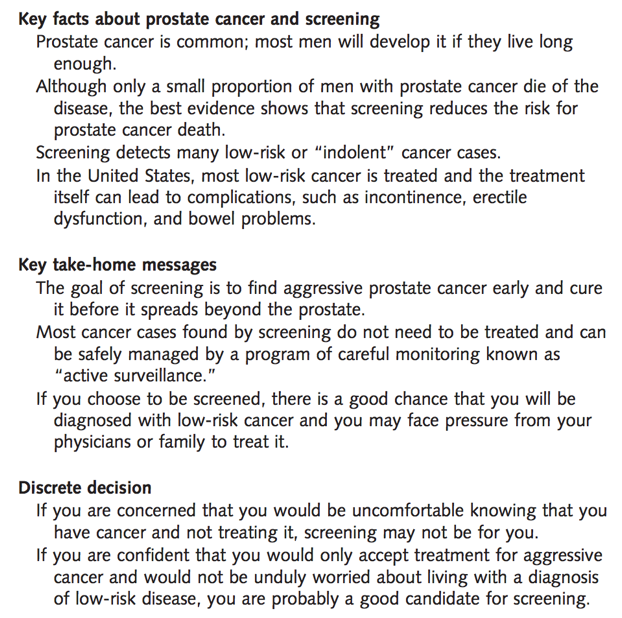For this study, a multidisciplinary research team was assembled comprising experts in primary care and urology, behavioral sciences, and bioinformatics in order to develop version 1 of the decision support tool. The algorithm followed the National Comprehensive Cancer Network (NCCN) guidelines and narratives were developed using principles from behavioral economics, prompting primary care physicians to follow guideline-recommended directions. A provider-facing tool for shared decision making was also incorporated into the tool. The decision support tool was presented to a focus group of 10 primary care physicians from Brigham and Women's Hospital Primary Care in Boston, highlighted as follows:2

The focus group followed standard procedures. Open-ended questions were asked, and a survey was distributed to obtain qualitative and quantitative feedback. Notes were taken during the focus group, which was also audio-recorded, and transcribed verbatim through an independent service. Transcriptions were coded by two independent researchers, one of which was not involved in the conception and design of the study. Notes and transcripts were analyzed inductively to develop codes and themes using thematic content analysis.
The sample was representative of the demographic distribution of physicians in terms of age, gender, ethnicity, and years in practice. Three major themes arose from the data:
- Confirmatory reactions regarding the importance, innovation, and unmet need for a decision support tool embedded in the electronic medical record (“That is the power of computers actually”, “Having this guideline makes me feel more comfortable with ordering the initial PSA”)
- Issues around implementation and application of the tool in clinic workflow (“How many minutes do you have on average for your visits? Negative five”) and physicians own clinical bias coloring conversations (“My grandfather and father had prostate cancer, they both had really awful side-effects from treatment…and I try to get rid of that bias.”)
- Attitudes/reflections regarding discrepant recommendations from various guideline groups that cause confusion (“The guidelines all over the place”)
Dr. Carlsson concluded with the following take-home messages:
- There was overwhelmingly positive support from for the need of a provider-facing decision support tool to assist with PSA screening decisions in primary care
- Incorporation of the suggestions from the primary care physicians from this focus group into version 2 of the decision support tool will be used in subsequent pilot testing in clinic.
Written by: Zachary Klaassen, MD, MSc, Assistant Professor of Urology, Georgia Cancer Center, Augusta University/Medical College of Georgia, Augusta, GA, USA, Twitter: @zklaassen_md, at the 2020 American Urological Association (AUA) Annual Meeting, Virtual Experience #AUA20, June 27- 28, 2020
References:
- Jiang C, Fedewa SA, Wen Y, et al. Shared Decision Making and Prostate-Specific Antigen Based Prostate Cancer Screening Following the 2018 Update of USPSTF Screening Guideline. Prostate Cancer Prostatic Dis. 2020 Apr 15 [Epub ahead of print].
- Vickers AJ, Edward K, Cooperberg MR, et al. A Simple Schema for Informed Decision Making about Prostate Cancer Screening. Ann Intern Med. 2014;161:441-442.


